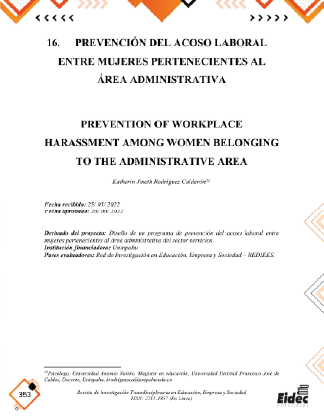XVI. PREVENTION OF WORKPLACE HARASSMENT AMONG WOMEN BELONGING TO THE ADMINISTRATIVE AREA
##plugins.themes.bootstrap3.article.main##
Abstract
In the last decades in Colombia, the concern has increased related to the dynamics
within organizations, especially about well-being and the organizational environment,
understanding that these factors don’t only affect the productivity and competitiveness of an
organization, but the lives of the people who work there and their families as well.
In addition, there’s been incidence on indicators associated to workplace’s difficulties
like harassment and the promulgation of Law 1010 of 2006, which define a route of
delimitation, correction and sanction of this phenomenon at the country level, demanding
strategies of prevention. Therefore, workplace harrasement is considered a relevant issue for
research and organizational dynamics.
The main objective of this study is to design a workplace harassment prevention
program for women who’re currently working into an administrative area. For this purpose,
surveys and focus group are applied as information collection instruments, which allow us to
understand the relational perspective of this type of workplace harassment, using tools such
as gossiping, rumors and other aggressions.
The program is designed based on the collected information, which is subsequently
validated by experts using the Delphi method. As a result, a didactic tool is created with
academic purposes.
Download Statistics
##plugins.themes.bootstrap3.article.details##
Workplace Harassment, Workplace harassment between women, Prevention, Pedagogical resource.
productividad empresarial: El caso español. Revista Perspectivas, (38), 25-44.
Recuperado en 25 de mayo de 2022, de
http://www.scielo.org.bo/scielo.php?script=sci_arttext&pid=S1994-
37332016000200003&lng=es&tlng=es.
Barrado, V., & Prieto, J. (2016). El acoso laboral como factor determinante en la
Camacho, R. (2018). Acoso laboral o mobbing. Bogotá: Editorial Universidad del rosario.
DOI: doi.org/10.12804/tj9789587841619
Congreso de Colombia. (enero 23, 2006). Ley 1010, Por medio de la cual se adoptan medidas
para prevenir, corregir y sancionar el acoso laboral y otros hostigamientos en el marco
de las relaciones de trabajo. DO 46.160.
http://www.secretariasenado.gov.co/senado/basedoc/ley_1010_2006.html
Consulta 2 de septiembre de 2021]. ISSN: 1994-3733. Disponible en:
Departamento Administrativo Nacional de Estadística. (2022). Boletín Técnico
Escobar, B, & Fernández M. (2012). Mobbing: acoso moral o psicológico en el
trabajo. Verba Luris, (28), 135–151. Recuperado a partir de
https://revistas.unilibre.edu.co/index.php/verbaiuris/article/view/2208
Fernández, M. (2005). La noción de violencia simbólica en la obra de Pierre Bourdieu: una
aproximación crítica. Cuadernos de Trabajo Social 7 (18), 7-31. Recuperado de
https://revistas.ucm.es/index.php/CUTS/article/view/CUTS0505110007A
González, T, & Delgado, M. (2008). El acoso psicológico en el lugar de trabajo antecedentes
organizacionales. Boletín de Psicología (93), 7-20. Recuperado de
https://www.uv.es/seoane/boletin/previos/N93-1.pdf
Gran Encuesta Integrada de Hogares (GEIH) Enero – marzo 2022. Recuperado de
https://www.dane.gov.co/files/investigaciones/boletines/ech/ech_genero/boletin_GE
IH_sexo_ene22_mar22.pdf
https://www.redalyc.org/articulo.oa?id=425948032003
Ministerio de trabajo (2017). Informe gestión - primer trimestre año 2.017 programa
nacional de servicio al ciudadano colabora. Recuperado de https://n9.cl/n4rmc productividad empresarial: El caso español. PERSPECTIVAS, (38),25-44. [fecha de
Rodríguez, C. (2021). Cuerpo, sujeto y violencia desde las narrativas y la experiencia de
mujeres estudiantes (Tesis de maestría). Universidad Francisco José de Caldas,
Bogotá, Colombia.
Torres, C. (2012). La violencia escolar femenina: una mirada desde los adolescentes (Tesis
de doctorado). Universidad Francisco José de Caldas, Bogotá, Colombia.





